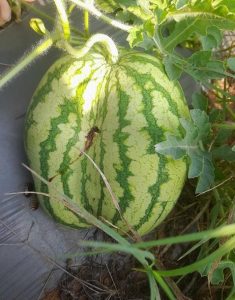Watermelon and muskmelon crops are hosts of different insects which may cause crop loss. Melon fruit fly, scientifically known as the Bactrocera cucurbitae, is a major pest that affects melon crops. These tiny, orange to brown coloured insects can cause significant damage to melon crops by feeding on the economical part, fruit making them unfit for marketability. These fruit flies are known for their ability to quickly reproduce and spread, making them a significant threat to melon production. Early detection and effective management strategies are crucial to minimize the damage caused by melon fruit fly infestations and prevent economic losses for growers.
How does Fruit flies cause damage to Melons?

- Female fruit fly pierce the fruit skin and lays eggs on the fruit leaving behind small puncture marks on the fruit surface.
- These oviposition marks may serve as a source for secondary infections by fungi and bacteria.
- Small discoloured patches appears on the fruit surface.
- As the fruit fly larvae hatch, they feed on the fruit’s flesh, leaving behind a mushy residue.
- Sunken, soft or mushy spots can cause the fruit to rot and become unusable.
- As the melon begins to rot due to fruit fly infestation, foul smell will be emitted.
- Presence of resinous fluid oozing out from fruits.
- Fruit fly infected fruits are usually malformed and distorted.
Preventive Measures:
Cultural Practices:
- Maintain good field sanitation practices. Bury the damaged fruits deep in the soil to prevent adult fly elusion.
- Deep ploughing may help to expose the pupae.
- Crop rotation with legumes, corn or brassicas disrupts its life cycle.
- Trap crops such as bitter gourd and cucumber can be planted near melon crops to attract fruit flies away from the melons.
- Adjust the sowing time to reduce the infestation as the fly population peaks in rainy season and low in hot day conditions.
Traps:
- Use 6 – 8 Tapas fruit fly pheromone trap per acre field to monitor and control fruit fly population.
- Yellow sticky traps will be most effective in trapping adult flies as they are attracted to bright yellow colour. Install 4 – 6 yellow sticky traps for 1 acre field.
- Citronella oil, eucalyptus oil, vinegar, and lactic acid can be used to attract fruit flies. A few drops of these attractants can be added to the trap or sticky paper to lure fruit flies.
Bait traps:
- Food baits (sugar-based or protein-based baits) can be used to control fruit flies in melon. For example, ripe banana or sugar and yeast mixture can be used in traps to capture and kill fruit flies. Methyl eugenol can also be used in fruit fly traps to lure and kill male fruit flies.
Physical Barrier:
- Spray Kaolin clay on the leaves and fruits of melon plants as it acts as a physical barrier that can deter fruit flies.
- Bagging of fruits using paper or cloth bag during fruiting stage to avoid fruit flies laying eggs.
Biological:
- Introduce natural enemies such as parasitic wasps.
- Spray neem oil at 2 – 3 ml/lit water.
ITK Practices to control fruit flies:
- Smoking by rice straw and chilli powder during fruiting stage can create unbearable odour and help to prevent fruit flies.
- Neem leaves can be crushed and soaked in water, and the resulting solution can be sprayed on the melon plants to repel fruit flies.
- 20 gm of basil leaves can be crushed and the extract of it along with the crushed leaves can be placed inside a coconut shell. Also fill it with 100 ml of water. 0.5 gm citric acid is added to increase its keeping quality. The extract is then poisoned by mixing 0.5 gm of carbofuran 3G. The traps are then suspended in the field.
Chemical Management:
| Product name | Technical content | Dosage |
| Coragen Insecticide | Chlorantraniliprole 18.5% SC | 0.3 ml/lit water |
| Karate Insecticide | Lambdacyhalothrin 5% EC | 1.5 – 1.7 ml/lit water |
| Decis 2.8 EC Insecticide | Deltamethrin 2.8 EC | 1.5 – 2 ml/lit water |
| Polytrin C 44 EC Insecticide | Profenofos 40% + Cypermethrin 4% EC | 2 ml/lit water |
| Alika Insecticide | Thiamethoxam 12.6% + Lambda-cyhalothrin 9.5% ZC | 0.5 ml/lit water |
| Fame Insecticide | Flubendiamide 39.35% SC | 0.5 ml/lit water |
| BACF Endtask Insecticide | Fipronil 40% + Imidacloprid 40% WDG | 0.5 gm/lit water |
Conclusion:
Controlling fruit fly infestations is important to minimize the damage caused by the pest and prevent crop loss. Various preventive and control strategies, such as traps, insecticides, and cultural practices mentioned above can be practiced to prevent or reduce fruit fly infestations and achieve better yield and quality produce.





